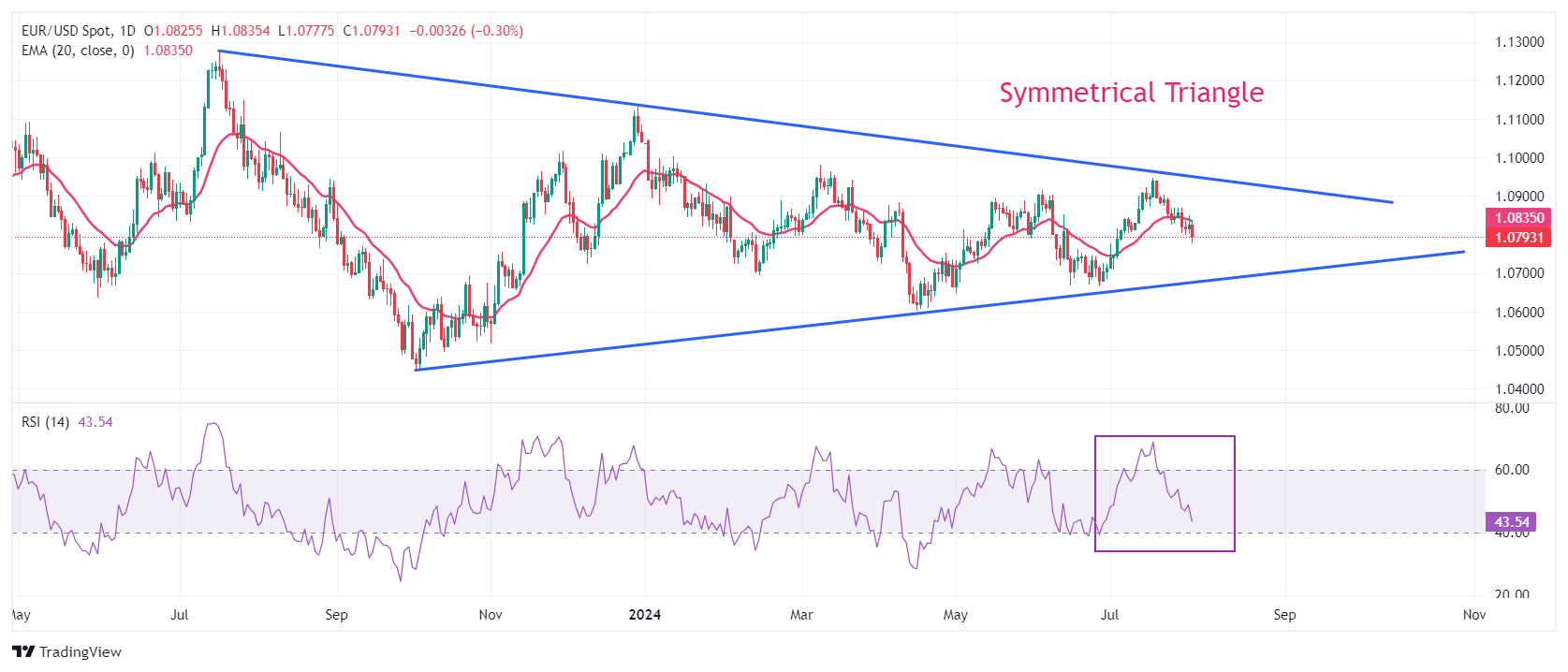EUR/USD Price Analysis: 20-day EMA acts as key barrier for Euro bulls


- EUR/USD falls sharply as the US Dollar bounces back strongly.
- The US Dollar recovers ahead of the US ISM Manufacturing PMI and the NFP data for July.
- Faster-than-expected Eurozone inflation growth has raised doubts over speculation of an ECB rate cut in September.
The EUR/USD pair faces an intense sell-off after breaking below the round-level support of 1.0800 and posts a fresh three-week low at 1.0777 in Thursday’s European session. The major currency pair weakens after a sharp recovery in the US Dollar (USD). The US Dollar Index (DXY), which tracks the Greenback’s value against six major currencies, surges to 104.40 after recovering from a fresh weekly low of 103.86.
The US Dollar rose as market participants had already discounted the Federal Reserve’s (Fed) dovish guidance on interest rates in the monetary policy announcement on Wednesday. The Fed kept borrowing rates steady in the range of 5.25%-5.50%. Fed Chair Jerome Powell said policymakers have gained greater confidence from the Q2 inflation data.
When asked about rate cuts in September, Powell replied, "If we were to see inflation moving down more or less in line with expectations, growth remains reasonably strong, and the labor market remains consistent with current conditions, then I think a rate cut could be on the table at the September meeting”, Reuters reported.
Going forward, investors will focus on the United States (US) ISM Manufacturing PMI and Nonfarm Payrolls (NFP) report for July, which will be published at 14:00 GMT and on Friday, respectively.
Meanwhile, faster-than-expected growth in preliminary Eurozone Harmonized Index of Consumer Prices (HICP) data for July has raised doubts about whether the European Central Bank (ECB) will cut interest rates in September.
EUR/USD trades inside a Symmetrical Triangle formation on a daily timeframe, which exhibits a sideways trend. The aforementioned chart pattern signifies a sharp volatility contraction, which is expected to remain for a while amid the absence of clear signals of a breakout or a breakdown.
The shared currency pair faces selling pressure near the 20-day Exponential Moving Average (EMA) around 1.0835, suggesting that the near-term trend is bearish.
The 14-day Relative Strength Index (RSI) oscillates in the 40.00-60.00 range, indicating indecisiveness among market participants.
A fresh downside could appear if the asset breaks below the round-level support of 1.0700, which will expose the asset to June 26 low at 1.0666, followed by April 16 low around 1.0600.
On the flip side, an upside move above June 3 high near 1.0900 will drive the asset towards July 17 high at 1.0948 and the psychological resistance of 1.1000.

EUR/USD daily chart
Euro FAQs
What is the Euro?
The Euro is the currency for the 20 European Union countries that belong to the Eurozone. It is the second most heavily traded currency in the world behind the US Dollar. In 2022, it accounted for 31% of all foreign exchange transactions, with an average daily turnover of over $2.2 trillion a day. EUR/USD is the most heavily traded currency pair in the world, accounting for an estimated 30% off all transactions, followed by EUR/JPY (4%), EUR/GBP (3%) and EUR/AUD (2%).
What is the ECB and how does it impact the Euro?
The European Central Bank (ECB) in Frankfurt, Germany, is the reserve bank for the Eurozone. The ECB sets interest rates and manages monetary policy. The ECB’s primary mandate is to maintain price stability, which means either controlling inflation or stimulating growth. Its primary tool is the raising or lowering of interest rates. Relatively high interest rates – or the expectation of higher rates – will usually benefit the Euro and vice versa. The ECB Governing Council makes monetary policy decisions at meetings held eight times a year. Decisions are made by heads of the Eurozone national banks and six permanent members, including the President of the ECB, Christine Lagarde.
How does inflation data impact the value of the Euro?
Eurozone inflation data, measured by the Harmonized Index of Consumer Prices (HICP), is an important econometric for the Euro. If inflation rises more than expected, especially if above the ECB’s 2% target, it obliges the ECB to raise interest rates to bring it back under control. Relatively high interest rates compared to its counterparts will usually benefit the Euro, as it makes the region more attractive as a place for global investors to park their money.
How does economic data influence the value of the Euro?
Data releases gauge the health of the economy and can impact on the Euro. Indicators such as GDP, Manufacturing and Services PMIs, employment, and consumer sentiment surveys can all influence the direction of the single currency. A strong economy is good for the Euro. Not only does it attract more foreign investment but it may encourage the ECB to put up interest rates, which will directly strengthen the Euro. Otherwise, if economic data is weak, the Euro is likely to fall. Economic data for the four largest economies in the euro area (Germany, France, Italy and Spain) are especially significant, as they account for 75% of the Eurozone’s economy.
How does the Trade Balance impact the Euro?
Another significant data release for the Euro is the Trade Balance. This indicator measures the difference between what a country earns from its exports and what it spends on imports over a given period. If a country produces highly sought after exports then its currency will gain in value purely from the extra demand created from foreign buyers seeking to purchase these goods. Therefore, a positive net Trade Balance strengthens a currency and vice versa for a negative balance.





.jpg)